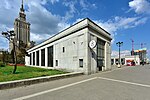Collegium Civitas
Collegium Civitas

Collegium Civitas is a private university for the social sciences located in Warsaw, the capital of Poland. It is open to new inventions in higher education: interdisciplinary approaches, closer lecturer-student relations, study abroad programs, internships, and the encouragement and supervision of individual student research projects.
Excerpt from the Wikipedia article Collegium Civitas (License: CC BY-SA 3.0, Authors, Images).Collegium Civitas
Plac Defilad, Warsaw Śródmieście (Warsaw)
Geographical coordinates (GPS) Address Website Nearby Places Show on map
Geographical coordinates (GPS)
| Latitude | Longitude |
|---|---|
| N 52.231667 ° | E 21.006389 ° |
Address
Pałac Kultury
Plac Defilad 1
00-110 Warsaw, Śródmieście (Warsaw)
Masovian Voivodeship, Poland
Open on Google Maps










